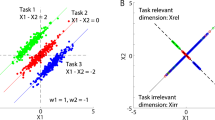Abstract
Recent theories of motor control have proposed that the nervous system acts as a stochastically optimal controller, i.e. it plans and executes motor behaviors taking into account the nature and statistics of noise. Detrimental effects of noise are converted into a principled way of controlling movements. Attractive aspects of such theories are their ability to explain not only characteristic features of single motor acts, but also statistical properties of repeated actions. Here, we present a critical analysis of stochastic optimality in motor control which reveals several difficulties with this hypothesis. We show that stochastic control may not be necessary to explain the stochastic nature of motor behavior, and we propose an alternative framework, based on the action of a deterministic controller coupled with an optimal state estimator, which relieves drawbacks of stochastic optimality and appropriately explains movement variability.
Similar content being viewed by others
References
Atkeson, C., & Hollerbach, J. (1967). Kinematic features of unrestrained vertical arm movements. Journal of Neuroscience, 5(9), 2318–2330.
Bernstein, N. (1967). The Co-ordination and regulation of movements. Oxford: Pergamon.
Bryson, A. (1999). Dynamic optimization. Englewood Cliffs, NJ: Prentice Hall.
Bryson, A., & Ho, YC. (1975). Applied optimal control – Optimization, estimation, and control. New York: Hemisphere.
Burdet, E., & Milner, T. (1998). Quantization of human motions and learning of accurate movements. Biological Cybernetics, 78(4), 307–318.
Chhabra, M., & Jacobs, R. (2006a). Near-optimal human adaptive control across different noise environments. Journal of Neuroscience, 26(42), 10883–10887.
Chhabra, M., & Jacobs, R. (2006b). Properties of synergies arising from a theory of optimal motor behavior. Neural Computation, 18(10), 2320–2342.
Desmurget, M., & Grafton, S. (2000). Forward modeling allows feedback control for fast reaching movements. Trends in Cognitive Sciences, 4(11), 423–431.
Goodwin, G., & Sin, K. (1984). Adaptive filtering prediction and control. Englewood Cliffs, NJ: Prentice-Hall.
Gordon, J., Ghilardi, M., Cooper, S., & Ghez, C. (1994a). Accuracy of planar reaching movements. I. Independence of direction and extent variability. Experimental Brain Research, 99(1), 97–111.
Gordon, J., Ghilardi, M., Cooper, S., & Ghez, C. (1994b). Accuracy of planar reaching movements. II. Systematic extent errors resulting from inertial anisotropy. Experimental Brain Research, 99(1), 112–130.
Guigon, E., Baraduc, P., & Desmurget, M. (2007). Computational motor control: Redundancy and invariance. Journal of Neurophysiology, 97(1), 331–347.
Hamilton, A., & Wolpert, D. (2002). Controlling the statistics of action: Obstacle avoidance. Journal of Neurophysiology, 87(5), 2434–2440.
Harris, C., & Wolpert, D. (1998). Signal-dependent noise determines motor planning. Nature, 394, 780–784.
Hoff, B. (1994). A model of duration in normal and perturbed reaching movement. Biological Cybernetics, 71(6), 481–488.
Hoff, B., & Arbib, M. (1993). Models of trajectory formation and temporal interaction of reach and grasp. Journal of Motor Behavior, 25(3), 175–192.
Knill, D., & Pouget, A. (2004). The bayesian brain: The role of uncertainty in neural coding and computation. Trends in Neurosciences, 27(12), 712–719.
Li, W. (2006). Optimal control for biological movement systems. Ph.D. thesis, University of California, San Diego.
Meyer, D., Abrams, R., Kornblum, S., Wright, C., & Smith, J. (1988). Optimality in human motor performance: Ideal control of rapid aimed movement. Psychological Review, 95(3), 340–370.
Nelson, W. (1983). Physical principles for economies of skilled movements. Biological Cybernetics, 46(2), 135–147.
Novak, K., Miller, L., & Houk, J. (2000). Kinematic properties of rapid hand movements in a knob turning task. Experimental Brain Research, 132(4), 419–433.
Pélisson, D., Prablanc, C., Goodale, M., & Jeannerod, M. (1986). Visual control of reaching movements without vision of the limb. II. Evidence of fast unconscious processes correcting the trajectory of the hand to the final position of a double-step stimulus. Experimental Brain Research, 62(2), 303–311.
Saunders, J., & Knill, D. (2004) Visual feedback control of hand movements. Journal of Neuroscience, 24(13), 3223–3234.
Schaal, S., & Schweighofer, N. (2005). Computational motor control in humans and robots. Current Opinion in Neurobiology, 15(6), 675–682.
Scholz, J., & Schöner, G. (1999). The uncontrolled manifold concept: Identifying control variables for a functional task. Experimental Brain Research, 126(3), 289–306.
Scholz, J., Schöner, G., & Latash, M. (2000). Identifying the control structure of multijoint coordination during pistol shooting. Experimental Brain Research, 135(3), 382–404.
Stein, R., Gossen, E., & Jones, K. (2005). Neuronal variability: Noise or part of the signal? Nature Reviews Neuroscience, 6(5), 389–397.
Todorov, E. (2004). Optimality principles in sensorimotor controls. Nature Neuroscience, 7(9), 907–915.
Todorov, E. (2005). Stochastic optimal control and estimation methods adapted to the noise characteristics of the sensorimotor system. Neural Computation, 17(5), 1084–1108.
Todorov, E., & Jordan, M. (2002). Optimal feedback control as a theory of motor coordination. Nature Neuroscience, 5(11), 1226–1235.
Todorov, E., & Li, W. (2005). A generalized iterative LQG method for locally-optimal feedback control of constrained nonlinear stochastic systems. In: Proc American Control Conference (pp. 300–306).
Torres, E., & Zipser, D. (2004). Simultaneous control of hand displacements and rotations in orientation-matching experiments. Journal of Applied Physiology, 96(5), 1978–1987.
Trommershäuser, J., Gepshtein, S., Maloney, L., Landy, M., & Banks, M. (2005). Optimal compensation for changes in task-relevant movement variability. Journal of Neuroscience, 25(31), 7169–7178.
van Beers, R., Haggard, P., & Wolpert, D. (2004) The role of execution noise in movement variability. Journal of Neurophysiology, 91(2), 1050–1063.
van Beers, R., Sittig, A., & Denier van der Gon, J, (1999). Integration of proprioceptive and visual position-information: An experimentally supported model. Journal of Neurophysiology, 81(3), 1355–1364.
Wolpert, D., & Ghahramani, Z. (2000) Computational principles of movement neuroscience. Nature Neuroscience, 3(Supplement), 1212–1217.
Wolpert, D., Ghahramani, Z., & Jordan, M. (1995). An internal model for sensorimotor integration. Science, 269, 1880–1882.
Author information
Authors and Affiliations
Corresponding author
Additional information
Action Editor: Frances K. Skinner
Rights and permissions
About this article
Cite this article
Guigon, E., Baraduc, P. & Desmurget, M. Optimality, stochasticity, and variability in motor behavior. J Comput Neurosci 24, 57–68 (2008). https://doi.org/10.1007/s10827-007-0041-y
Received:
Revised:
Accepted:
Published:
Issue Date:
DOI: https://doi.org/10.1007/s10827-007-0041-y



